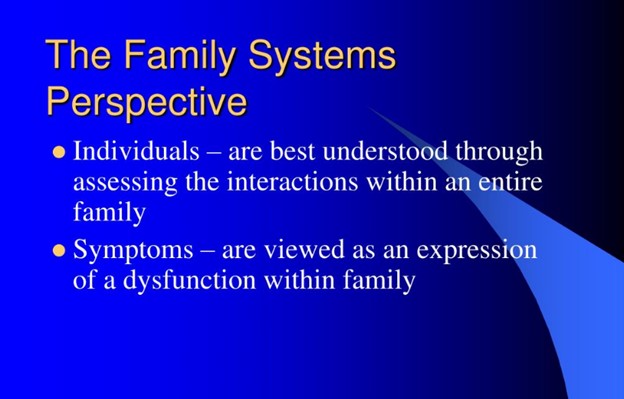Family Systems Therapy

Family Systems Therapy
James J. Messina, Ph.D.
Family Systems Therapy – Family Therapists Leaders –
Alfred Adler-Rudolf Driekurs-open forum Child Guidance Clinics
Murray Bowen-Multigenerational Model-Triangulation,
Differentiation of Self Virginia
Satir-Conjoint Family Therapy-Human Validation, Relational Family Therapy
Carl Whitaker-Experiential Symbolic Family Therapy-therapist coach influences change Salvador Minuchin-Structural Family Therapy-create structural change
Jay Haley-Strategic Family Therapy-solves problems now Cloe Madanes- Wife Haley-Strategic Family Therapy.
The Family Systems Perspective
Individuals ~ are best understood through assessing the interactions within an entire family.
Symptoms ~ are viewed as an expression of a dysfunction within a family.
Problematic behaviors ~
Serve a purpose for the family
Are a function of the family’s inability to operate productively
Are symptomatic patterns handed down across generations
A family ~ is an interactional unit and a change in one member affects all members.
Difference between Systemic & Individual Therapy models
| Individual Therapist | Systemic Therapist |
| Obtain accurate diagnosis DSM IV | Explore System for family process & rules |
| Begin Therapy right now | Invite in parents, siblings |
| Focus: causes, purposes, processes | Focus: family relationships |
| Concern with individual experience & perspective | Concern transgenerational meanings, rules |
| Intervene to help individual learn to cope | Intervene to change context within family system |
Beliefs of Family Therapists
Individual’s affiliations & interactions have more power in person’s life than a single therapist could ever hope to have
Working with family or community therapists sees how individual acts and serves needs of these systems
Seeing individuals active in a system assists in developing types of interventions needed.
Systemic Perspective
Individual may carry a symptom for the entire family
Individual’s functioning is a manifestation of way family functions
Individual can have symptom existing independent of family structure
Symptoms always have ramifications for family members
Change the systems and individuals will change
Change dysfunctional patterns of relating & create functional ways of interacting & relating
Adlerian Family Therapy Outline
1.Key Concepts
2.Therapy Goals
3.Therapist’s functions
Adlerian Family Therapy Key Concepts
Use A Educational Model to Cousel Families
Emphasizes is on Family Atmospheres and Family Constellation
Therapists function as collaborators who seek to join the family
Parent Interview hunches about the purposes underlying children’s behavior
Family Atmosphere
◼ Unique: conjunction of all the family forces climate of relationships that exist between people
◼ Family is a system & each member exerts influence on every other member
◼ Autocratic or permissive common in West
◼ Parent role model of how genders relate, how to work, participate in world
◼ Emotional role models for children as well
◼ Family value: value all members support & cannot be ignored: religion, education, money achievement, right and achievement, right and wrong.
Family Constellation
◼ Consists of parents, children, extended family members
◼ Birth order
◼ How member find place in family system & how relate to one another to be unique
◼ Alignment of family members
◼ Develop genogram of family-starting point for client communication meaning of life
Role of Birth Order
Motivates later behavior:
◼ First-born: favored, only, pseudo-parent high achievers
◼ Second-born: rivalry & competition
◼ Last-born: more pampered, “baby”- creative, rebellious,
Adler’s five psychological positions:
1. Oldest child ~ receives more attention, spoiled, center of attention
2. Second of only two ~ behaves as if in a race, often opposite to first child
3. Middle ~ often feels squeezed out
4. Youngest ~ the baby
5. Only ~ does not learn to share or cooperate with
other children, learns to deal with adults
Mistaken Goals: Interactional View
◼ Four goals for children’s behaviors:
◼ Attention getting
◼ Power struggle
◼ Revenge
◼ Demonstration of inadequacy
◼ Short hand explanations, descriptions of consistent patterns
◼ Describe child’s misbehavior
◼ Parent’s reaction to behavior
◼ Child’s reaction to parents’ attempt to discipline
◼ Mistaken Goal: recognition flex –smile, twinkle
◼ Goal recognition and disclosure
Adlerian Family Therapy Goals
◼Unlock mistaken goals and interactional patterns
◼ Engage parents in a learning experience and a collaborative assessment
◼ Emphasis is on the family’s motivational patterns
◼ Main aim is to initiate a reorientation of the family
◼ Assist family member to have Social Equality the sense that everyone has an equal right to be valued and respected in the family
Adlerian Therapist Functioning
◼Open forum
◼ Parent Interview alone they are leaders
◼ Problem Description parents concerns
◼ Goal Identification What did you do about it?
◼ Typical Day repeated patterns of interaction
◼ Child Interview
◼ Goal Disclosure Do you know why you do…
◼ Posit tentative goals: Could it be that…
◼ Concluding Remarks to generate new approaches to end mistaken interactions to lead to more democratic, harmonious, effective living
Multigenerational Family Therapy Outline-Murray Bowen
1. Key Concepts
2. Therapy Goals
3. Therapist’s functions
Multigenerational Family Therapy Murray Bowen 8 Key Concepts
The application of rational thinking to emotionally saturated systems. A well-articulated theory is essential….
1. Differentiation of the self
2. Triangulation
3. Nuclear Family Emotional System
4. Family Projection Process
5. Emotional cutoff
6. Multigenerational transmission process
7. Sibling position
8. Societal regression
Differentiation of the self
◼ A psychological separation of intellect & emotion & independence of self from others
◼ Differentiated =Being able to be guided by thoughts or emotions – separateness
◼ Undifferentiated=difficulty separating self from others-fuse with dominant family emotional patterns-physical but not emotional leaving
◼ Unproductive family dynamics of previous generation transmitted by marriage of undifferentiated individuals
◼ Need for self-identify while still belonging to one’s family
Triangulation
A third party is recruited to reduce anxiety and stabilize a couple’s relationship
◼ Underlying conflict not addressed & worsens
◼ Once the 3rd person is resolved the balance achieved is off again
◼ Change in one part of family system affects the whole system
◼ Therapist must be highly differentiated so as not to get caught up in triangulation with couple
Multigenerational Family Therapy Goals
◼ With the proper knowledge the individual can change
◼ Change occurs only with other family members
◼ To change the individuals within the context of the system
◼ To end generation-to-generation transmission of problems by resolving emotional attachments
◼ To lessen anxiety and relieve symptoms
◼ To increase the individual member’s level of differentiation
Multigenerational Family Therapy Therapist Functioning
◼ Genogram work: look at family over three generations
◼ Look for critical turning points in family emotional process
◼ Characteristics of family members
◼ Evolutional picture of family: tools for assessment
◼ Asking Questions: What role did you play with that person in the family? Looking for fusion within the family.
Conjoint Family Therapy Outline
1. Key Concepts
2. Therapy Goals
3. Therapist’s functions
Read Much More Inside…
GRAB YOUR COPY NOW ONLY $17.00

Click on the Blue Button Below for Instant Access!
![]()
Just use your name and valid email address – I will never sell or share your email address with anyone. Never. You may unsubscribe anytime. I hate spam just as much as you do.
Regards, Coyalita
Behavioral Health Rehabilitative Specialist & Addiction Counselor
Copyright © 2021-2023 Thresholdlivecoyalita.com All Rights Reserved Privacy Policy – Earnings Disclaimer – Terms of Use – Contact Us




